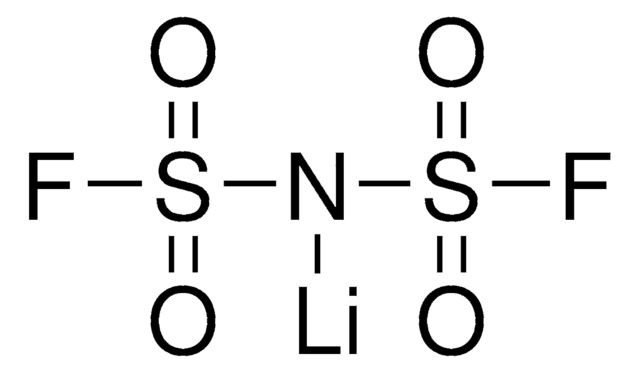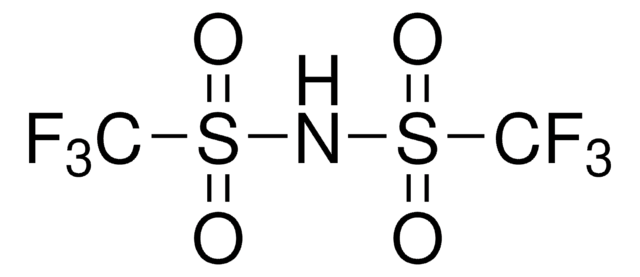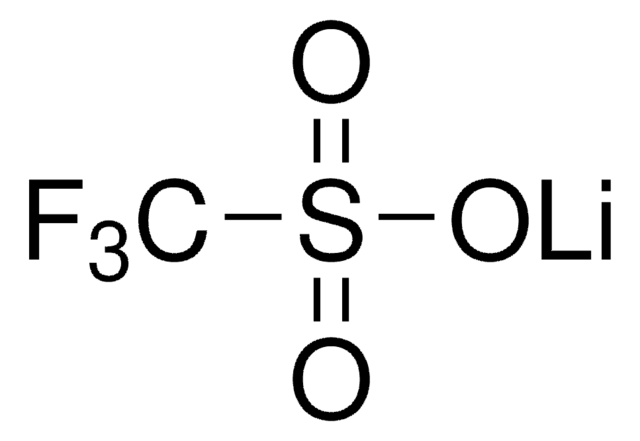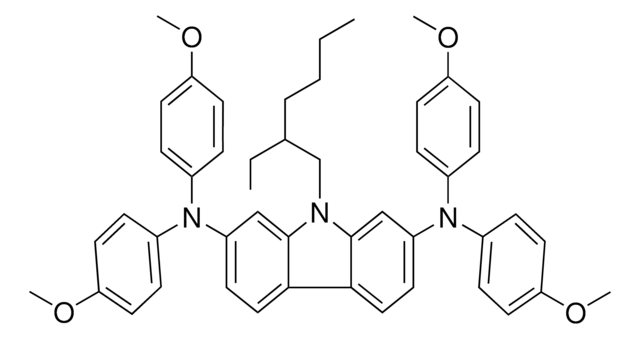544094
Bis(trifluormethan)sulfonimid Lithiumsalz
99.95% trace metals basis
Synonym(e):
Bis(trifluormethylsulfonyl)amin Lithiumsalz, Lithiumbistrifluormethansulfonimidat
About This Item
Empfohlene Produkte
Qualitätsniveau
Assay
99.95% trace metals basis
mp (Schmelzpunkt)
234-238 °C (lit.)
SMILES String
[Li]N(S(=O)(=O)C(F)(F)F)S(=O)(=O)C(F)(F)F
InChI
1S/C2F6NO4S2.Li/c3-1(4,5)14(10,11)9-15(12,13)2(6,7)8;/q-1;+1
InChIKey
QSZMZKBZAYQGRS-UHFFFAOYSA-N
Suchen Sie nach ähnlichen Produkten? Aufrufen Leitfaden zum Produktvergleich
Allgemeine Beschreibung
LiTFSI weist hohe ionische Leitfähigkeit und elektrochemische Stabilität auf. Wird als Elektrolytadditiv in Energiespeichergeräten verwendet.
Anwendung
- Als ionische Flüssigkeit bei der Herstellung von Gelpolymerelektrolyten (GPE) mit dem Foliengießverfahren (Solution-Casting).
- Zur Herstellung einzigartiger nicht entzündbarer Elektrolyten mit einer Wärmestabilität über 200 °C und einer besonders hohen Überführungszahl für Lithium-Ionen-Batterien.
- Als Elektrolyt für Li-O2 -Batterien.
- Zur Herstellung der festen Polymerelektrolyten für Lithiumbatterien.
Signalwort
Danger
H-Sätze
Gefahreneinstufungen
Acute Tox. 3 Dermal - Acute Tox. 3 Oral - Aquatic Chronic 3 - Eye Dam. 1 - Skin Corr. 1B - STOT RE 2 Oral
Zielorgane
Nervous system
Lagerklassenschlüssel
6.1B - Non-combustible acute toxic Cat. 1 and 2 / very toxic hazardous materials
WGK
WGK 3
Flammpunkt (°F)
Not applicable
Flammpunkt (°C)
Not applicable
Persönliche Schutzausrüstung
Eyeshields, Faceshields, Gloves, type P3 (EN 143) respirator cartridges
Hier finden Sie alle aktuellen Versionen:
Besitzen Sie dieses Produkt bereits?
In der Dokumentenbibliothek finden Sie die Dokumentation zu den Produkten, die Sie kürzlich erworben haben.
Kunden haben sich ebenfalls angesehen
Artikel
Ionic liquids, also called room temperature ionic liquids, are organic salts that are liquid at, or close to, room temperature.
Unser Team von Wissenschaftlern verfügt über Erfahrung in allen Forschungsbereichen einschließlich Life Science, Materialwissenschaften, chemischer Synthese, Chromatographie, Analytik und vielen mehr..
Setzen Sie sich mit dem technischen Dienst in Verbindung.














